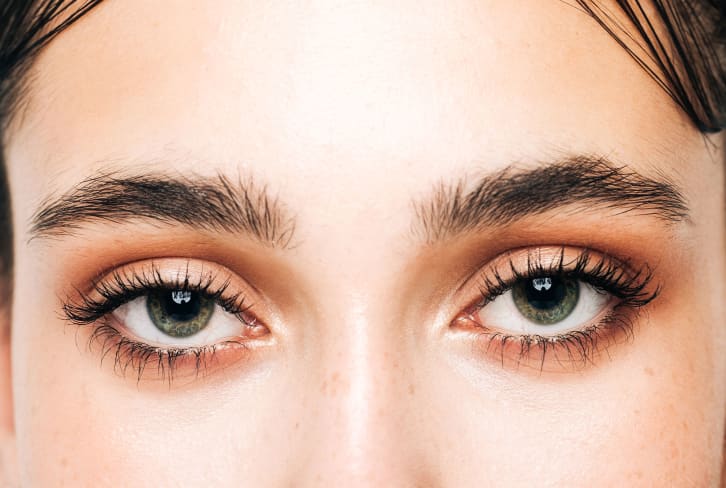Advertisement
Do You Actually Need A Facial Steamer? Benefits, Risks & How To Use It

Skin care does not need to be fancy—you can absolutely get by with a simple cleanse, treat, moisturize regimen. No need to opt for all the bells and whistles, but that's not to say those additions are totally superfluous. Some people love to indulge in tools, masks, and devices that give the skin a little something extra, and we'd certainly toss facial steamers into that camp.
Now, do you need a facial steamer? No, not really. But they can be a worthy investment for some—and when used correctly (correctly being the operative word here), they can provide a host of benefits. Allow the experts to explain.
What is facial steaming?
"Facial steaming is the process of applying hot water vapor to your face for a short period," explains board-certified dermatologist Ife J. Rodney, M.D., founder of Eternal Dermatology. You can do this a few ways—facial steaming devices, saunas, steamy showers, et al.—but the point is to apply some degree of heat to your skin in order to reap the benefits.
Benefits
If you've ever received a professional facial, you may have noticed your esthetician using a steamer post-cleanse to open up the pores and make it easier for them to perform extractions—but facial steaming has benefits beyond popping blackheads (which you should never, ever do at home, anyway). Take a peek below:
Opens up pores
First and foremost, the warmth from the steam opens up the pores and loosens trapped dirt, bacteria, and sebum. (Again, that's why many facialists steam pre-extractions.) But dissolving all the gunk within your pores before, say, an exfoliating mask or scrub may help the product work even better.
Hydrates
"Facial steaming may provide a hydrating effect with water vapor, which may keep your skin moisturized, plumper, and supple," says Rodney. See, as the heat opens up your pores, those water vapor molecules can shimmy their way through the dermis and plump your skin with hydration.
Brightens skin tone
"Facial steaming also dilates your skin blood vessels, which promotes healthy circulation to the skin," says board-certified dermatologist Kim Nichols, M.D., founder of NicholsMD of Greenwich, and stimulating blood flow often leads to a more radiant complexion. Not to mention, that extra hydration can also lead to a brighter glow: "When your skin lacks water, it appears dull with an uneven skin tone," Nichols reminds us.
Boost skin care products
Some people use facial steaming to improve the potency of their subsequent skin care products, says Rodney. "It loosens the dirt and opens your pores, so serums, toners, and eye creams work better," she notes.
Softens dead skin
"Utilizing a facial steamer softens the skin and dead cells on the epidermis," Nichols says, and breaking up dead skin cells can also help subsequent skin care products work better. After all, that pillowy hyaluronic acid serum can't do its job effectively with a wall of excess dead skin in the way.
Relaxing
A cloud of warm mist over your face just sounds soothing, no? While you shouldn't steam your face every single day (more on that in a bit), many people opt for a steamer whenever they crave an at-home spa day. Sometimes the sensorial experience alone is reason enough to snag a portable device.
You could even add a few drops of your favorite skin-safe essential oil to really encourage a spa-grade experience. Although, if you're sensitive to essential oils, you might want to stick with plain water.
Side effects
Yes, facial steamers have their fair share of benefits, but they're not for everyone nor are they without their drawbacks.
- It may actually dehydration. While steaming can effectively rehydrate the skin, it can also cause dehydration if you do it too often. "Just like over-exfoliating, over-steaming may trigger a process called transepidermal water loss," says Nichols. "This is when water passes from the dermis through the epidermis and evaporates from the skin's surface."
- Strip the skin of its protective oils. Over-steaming can also strip the skin of its natural oils, which can leave the skin so parched that it overproduces even more oil to compensate.
- Heat can trigger hyperpigmentation, broken capillaries, or a ruddy complexion. And dilating blood vessels can promote circulation and lead to a brighter skin tone, but, again, you don't want to overdo it. "Applying too much heat can damage the skin, possibly causing hyperpigmentation. You'll lose the benefits if you're not careful or it's too hot," Rodney warns. Frequently flushing your facial skin can even lead to broken capillaries or a ruddy complexion over time, Rachel Nazarian, M.D., of Schweiger Dermatology Group in NYC, previously told mbg.
Who shouldn't use facial steamers
Finally, steaming is not for everyone—some people just can't tolerate the heat, even sparingly. "If you have conditions like eczema, rosacea, or melasma, it can exacerbate them, so steer clear of steaming," Rodney notes, since that heat can trigger inflammation. (If you have sensitive skin in general, you might also want to avoid steamers.)
"You should also steer clear of steaming as a solution if you have acne. The skin is already inflamed, and applying heat will make things worse," she adds. Yes, steaming can prep the skin for extractions in a professional setting but only for comedones like blackheads or whiteheads. Estheticians will not touch inflamed mounds (and neither should you).
As a recap, avoid facial steamers if you experience the following:
- Eczema
- Rosacea
- Melasma
- Acne
- Broken capillaries
- Hyperpigmentation
How often should you steam?
"Once a week is probably a good start," says Morgan Rabach, M.D., a board-certified dermatologist and co-founder of LM Medical in NYC.
If your skin can tolerate it, you can increase the cadence up to two times a week, but Rodney says you definitely shouldn't steam more than that. "People of color should aim for once weekly, if at all," she adds. "Skin of color can become hyperpigmented much more quickly from excess steaming."
How to do it at home
Ready to steam? Carefully (!) try one of the methods below:
- Facial steamers: This is perhaps the most popular (yet pricey) option, as facial steaming devices provide a constant mist at a set temperature. They're also portable and convenient, with a sleek design and superfine spray. Just make sure you find a high-quality option, like the options we mentioned below—or in this roundup of our favorite facial steamers.
- The kettle method: "Before facial steamers, the tried-and-tested way was to fill a sink or face basin with hot water (from a kettle), then use a towel to cover the head and shoulders, making a dome to absorb the vapor from the hot water," explains Rodney. "The drawback from this is temperature control, as some people tend to use boiling hot water, which can irritate the skin."
- Hot towel: You can also run a soft, microfiber cloth under hot water, shake it out, then wrap it around your face for a minute or two. This method feels especially lovely after applying a clay mask, as the steam loosens up the product and provides another hit of exfoliation.
- In the shower: Or "crank your shower up and create an at-home spa in your bathroom," says Nichols. It really is that simple—just make sure you avoid touching the scalding spray, lest you burn your skin.
FAQ
Is a steamer good for your face?
Occasional facial steaming can be beneficial for some folks. Facial steaming can help open up pores prior to cleansing, hydrate skin, boost circulation, allow for deeper product penetration, and soften dead skin cells prior to exfoliation.
However, it’s not without its cautions: Just like over exfoliation can damage, skin over steaming is equally harming to the skin barrier. When done in excess it can damage the barrier, dehydrate the skin, cause flare ups of inflammatory skin conditions like rosacea, and even trigger hyperpigmentation from excess heat (this is especially true for those with darker skin tones, which are more prone to hyperpigmentation).
Most experts recommend sticking to only once a week, at most.
Do dermatologists recommend facial steamers?
Most dermatologists say you can use a facial steamer at home if you use it responsibly. As board-certified dermatologist Kim Nichols, M.D. notes, when done in excess it can actually dehydrate the skin, rather than hydrate it.
In addition, if you have inflammatory skin concerns like acne, rosacea, eczema, melasma, and are prone to dark spots or broken capillaries, derms suggest avoiding it entirely. "Applying too much heat can damage the skin, possibly causing hyperpigmentation. You'll lose the benefits if you're not careful or it's too hot," board-certified dermatologist Ife J. Rodney, M.D warns. “If you have conditions like eczema, rosacea, or melasma, it can exacerbate them, so steer clear of steaming.”
How often should you facial steam?
If you’re new to streaming, once a week is a good place to start. If you can tolerate it, then you can move to two times per week. However, those with darker skin tones should keep it to once. Finally, those who have inflammatory skin concerns like acne, rosacea, eczema, melasma, and are prone to dark spots or broken capillaries should avoid it altogether.
The takeaway
Facial steaming can hydrate, brighten, and soften the skin but only if you do it correctly. Make sure to follow the expert tips above and steer clear if you have conditions like rosacea, eczema, melasma, or inflamed acne. But when used with caution and care, facial steamers can be a solid investment for a DIY facial. Of course, steaming is just the first step: Find our full at-home facial tutorial here.
Watch Next
Enjoy some of our favorite clips from classes
Enjoy some of our favorite clips from classes
What Is Meditation?
Mindfulness/Spirituality | Light Watkins
Box Breathing
Mindfulness/Spirituality | Gwen Dittmar
What Breathwork Can Address
Mindfulness/Spirituality | Gwen Dittmar
The 8 Limbs of Yoga - What is Asana?
Yoga | Caley Alyssa
Two Standing Postures to Open Up Tight Hips
Yoga | Caley Alyssa
How Plants Can Optimize Athletic Performance
Nutrition | Rich Roll
What to Eat Before a Workout
Nutrition | Rich Roll
How Ayurveda Helps Us Navigate Modern Life
Nutrition | Sahara Rose
Messages About Love & Relationships
Love & Relationships | Esther Perel
Love Languages
Love & Relationships | Esther Perel




















